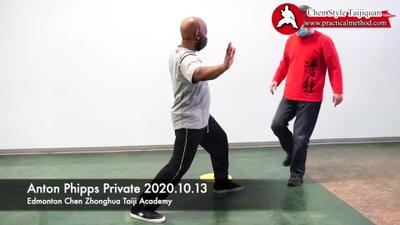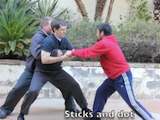Master Chen Zhon ghua’s Oct. 13, 2020 private lesson for Anton Phipps. This lesson used the applications of the first 13 moves of the Practical Method to illustrate how the moves are to be done.
Presenter: Chen Zhonghua Length: 58 min. In: English Year: 2020 Difficulty:3/5 At:Edmonton Chen Zhonghua Taiji Academy 埃德蒙顿陈中华太极馆







{ 1 comment… read it below or add one }
The lesson began with how to move naturally without reacting the opponent. Master Chen told me to close my eyes and just walk forward, but I could not help but react when I encountered resistance. Master Chen to the time to explain the purpose of Taiji and how this relates:
“The body must become a conduit so that it can move energy. Right now, your body is not a conductor, your body is a generator. Generators mean nothing, you stand here, [and] there is a power generator [over there] why would that have anything to do with you? It can make the noise [and] make the spark, but you need a wire to (…) zap you right? So our body, [sic] the problem is require conduits. So if it is electricity you are producing, we need wire. If it is water you produce, we need pipes. If it’s energy we need Taiji. The Taiji movements conduct energy, will transmit energy, human power energy.”
While letting me feel the power in action, Master Chen decided to elaborate on how exactly this energy is conducted, and speak about its origin:
“When you have a human body and you produce power, the power is produced on your legs from interacting with the floor, the foot. And then your body must move towards certain quality that the energy is conducted. And that most people believe is called loose, but looseness and hardness, all of those are attempts, or they are human understandings of how (…) to move your body in order to transmit that energy, and we actually believe it is called a stretch. And when you stretch something, humans can not stop it.”
At this point Master Chen had me begin isolating small stretches in my joints, identifying for me whether I was actually doing a stretch or if I was moving. This is a very difficult distinction to perform, though the feeling on the receiving end is completely different.
The rest of the class covered some more theory (on being where your opponent wants to go before they get there,) and more details on section 1 of Yilu. In the Yilu instruction, there were theoretical applications, but not for the sake of applications. (Not for the sake of fighting per se.) The purpose is to understand the intention behind the moves when you are practicing the form.